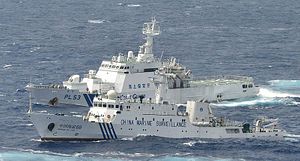It seems an ever-rising level of tension has become the norm in the East China Sea. From China’s new ADIZ to Shinzo Abe’s visit to Yasukuni Shrine; from angry op-eds written by Chinese and Japanese Ambassadors to Japan and China trading barbs over new fishing rules in the South China Sea, hardly a week goes by without some new incident pushing China and Japan farther apart (and closer towards conflict). This week was no exception.
Three Chinese Coast Guard vessels patrolled near the disputed Diaoyu/Senkaku Islands on Sunday morning, entering waters claimed by Japan. In response, Japanese Defense Minister Itsunori Onodera told reporters, “We can never overlook such repeated entries. In addition to diplomatic efforts, we will cooperate with Coast Guard and securely defend our territory and territorial waters around the Senkaku.” The Chinese Foreign Ministry lambasted Onodera’s comments, with spokesperson Hua Chunying warning Japan “not to underestimate China’s firm resolve and willpower in defending the national territorial sovereignty.”
This action and response is hardly new — Chinese Coast Guard vessels enter the disputed region rather routinely, apparently part of China’s strategy to slowly chip away at Japanese de facto administrative control of the islands. Chinese state media briefly noted similar patrols on December 8 and December 22, for example. However, this is first such incident since Abe’s hotly debated visit to Yasukuni Shrine, after which China-Japan ties took a particularly frosty turn. Now, in Chinese rhetoric the territorial debate is even more closely linked with Japan’s actions during World War II. In the Foreign Ministry press conference, Hua called Japan’s “erroneous position” on the territorial dispute an attempt “to deny the victory of the world anti-Fascist war.”
Meanwhile, even during the Chinese Coast Guard patrol of the contested region, Japan was holding its annual military drill. The drill, called “Island Defense,” had Japan’s elite airborne brigade practicing to retake an island — a not-so-subtle reference to the Senkaku/Diaoyu dispute. Such a drill, while a chilling reminder that the territorial dispute could one day escalate to armed conflict, was also nothing new. Both China and Japan had held military drills (and complained about the other parties’ drills) in the recent past. The Chinese Foreign Ministry had no specific comment on Sunday’s military exercise, though Monday’s press conference (as referenced above) did not shy away from lambasting Japan.
Ironically, this week marked a return to normalcy, in a sense. Having Chinese vessels enter the disputed region and Japanese troops conduct a pointed military drill is pretty much par for the course for China-Japan relations and for the Senkaku/Diaoyu dispute. We could see a return to the status quo that existed before high profile moves like China’s ADIZ announcement and Abe’s Yasukuni visit destabilized the situation even further.
On the other hand, the fact that these actions are fairly normal also speaks to how badly the situation has deteriorated in recent years. With officials from both countries publicly swearing to defend their territory, it’s hard to see how China and Japan can extricate themselves from the problem. That means the “new normal” of dueling coast guard patrols, military drills, and inflammatory press conferences is going to continue long into 2014.

































